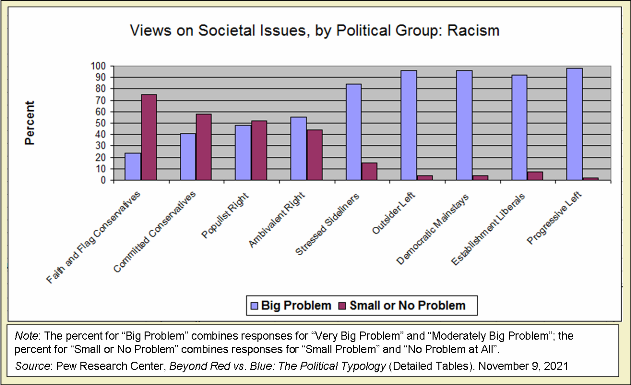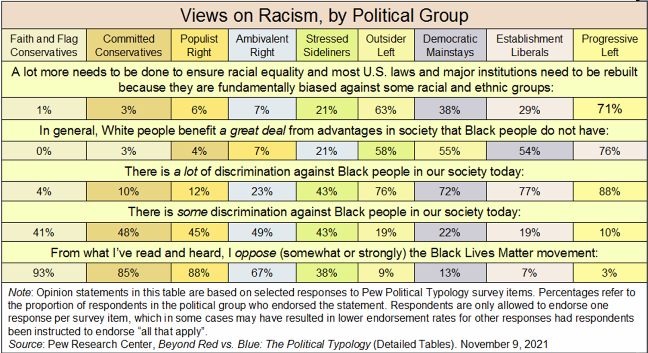Recap: Pew Research Center has released eight political typology reports since 1987. Its typologies sort Americans into “cohesive, like-minded groups based on their values, beliefs, and views about politics and the political system”. Pew’s latest typology divides the public into nine distinct groups, based on survey responses of 10,221 adults interviewed multiple times in 2020 and 2021. As described in Beyond Red vs. Blue: The Political Typology, these groups are:
Faith and Flag Conservatives: highly religious, politically engaged and both socially and economically conservative; favor robust role for religion in public life, smaller role for government, and a strong American military; remain strong supporters of former President Donald Trump.
Committed Conservatives: staunchly conservative and overwhelmingly Republican, hold pro-business views and favorable attitudes about international trade and a limited role of government; approach to international relations centers on engaging with allies and maintaining American military might.
Populist Right: hold highly restrictive views about immigration policy and are critical of government, big business/corporations, and the economic system as a whole; nearly half support higher taxes on the wealthy and on large corporations.
Ambivalent Right: views on the size of the federal government, business, gender and race are largely consistent with core conservative values; differ from some other segments of the GOP coalition by being less restrictive on immigration, more internationalist in foreign policy, and taking a moderate stance on several social issues.
Stressed Sideliners: generally disconnected from politics and the two major parties; represent substantial shares of both parties’ coalitions, yet have low voter turnout rate.
Outsider Left: hold liberal views on most issues and overwhelmingly voting Democratic; have deeply negative views of the GOP though not particularly enamored with the Democratic Party.
Democratic Mainstays: generally favor policies that expand the social safety net and support higher taxes on corporations; the largest single group as a share of the Democratic coalition, somewhat more hawkish than other Democratic-oriented groups on foreign policy and less liberal on immigration policy and some social issues.
Establishment Liberals: the typology group most likely to see value in political compromise and to be more inclined toward more measured approaches to societal change than their Progressive Left counterparts; the only Democratic-aligned group in which a majority of those who say a lot more needs to be done on issues such as racial equality yet also say this can be achieved by working within the current system.
Progressive Left: have very liberal views across a range of issues – including the size and scope of government, foreign policy, immigration and race. A sizable majority (79%) describe their views as liberal, including 42% who say their views are very liberal – double the share of the next largest group (20% of Outsider Left).
Here’s how these groups differ on whether they considered racism to be a big problem, small problem, or no problem at all:
The Range: Ninety-eight percent of the Progressive Left considered racism to be a very big or moderately big problem, compared with 24% of Faith and Flag Conservatives. Additionally, 75% of Faith and Flag Conservatives saw racism as a small problem or no problem at all, compared with 2% of the Progressive Left.
Related Opinions:
If I were a pollster, I’d take a subset of the survey respondents and ask them follow-up questions. For example,
Original question: How much more, if anything, needs to be done to ensure equal rights for all Americans regardless of their racial or ethnic backgrounds? Response options: A lot more needs to be done to ensure racial equality and most U.S. laws and major institutions need to be rebuilt because they are fundamentally biased against some racial and ethnic groups; A lot more needs to be done to ensure racial equality and while there are many inequities in U.S. laws and institutions, necessary changes can be made by working within the current system; a little; or nothing at all.
[To first response option] Could you elaborate? For example, what might be a law or institution that is fundamental biased and how does this bias manifest?
[To second response option] Could you elaborate? For example, how might working within the current system lead to necessary changes?
Original question: In general, how much do White people benefit from advantages in society that Black people do not have? Response options: a great deal; a fair amount; not too much; not at all.
Could you elaborate? For example, what might be some ways White people benefit from advantages in society that are less available to Black people?
Original question: Please tell us how much discrimination there is against Black people in our society today? Response options: A lot, some, only a little, or none at all.
Could you elaborate? For example, where does this discrimination take place (e.g., work, school, social, etc.) and how does it manifest?
Could you elaborate? For example, what might be some settings where discrimination is more pervasive and where it is less pervasive, e.g. work, school, social, military, church, etc.
Original question: From what you’ve read and heard, how do you feel about the Black Lives Matter movement? Response options: strongly support; somewhat support; somewhat oppose; strongly oppose.
Could you elaborate? For example, what do you see as the primary message of Black Lives Matter?
Notice that the follow-up questions are all open-ended. The purpose of these questions is to explore the respondents’ concerns, knowledge and understanding related to the topic being discussed, which is why they are open-ended. Compared to questions with a limited set of response options, open-ended questions are often more revealing of respondents’ true feelings and provide some insight into their thinking. As Richard Curtain, Director of the Survey Research Center at the University of Michigan, puts it: “open-ended questions are superior [to close-ended questions] in that they measure what is of most concern to the respondent without any prompting.” More surveys should include them.

